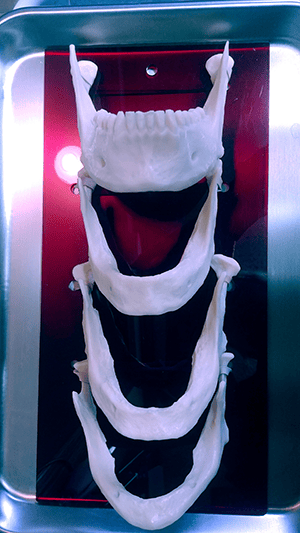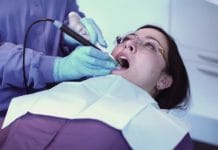Dentures. Sometimes we stumble across the patient who is insistent about full mouth extractions and upper and lower dentures. Dental professionals realize the importance of first doing the obvious, gathering all of the facts and data about the patient, which includes complete dental records and (most critical) good listening skills.
Why are these patients adamant about dentures? The reasons patients give may not be adequate reasons for them to sign up for a lifetime commitment to complete dentures.
During motivational interviewing (MI), for example, it often is discovered that the patient’s parents had dentures at his/her age and also feels destined for dentures. Or, perhaps the patient hasn’t been to the dentist in many years, and the fear of dental restorative work outweighs the fear of full mouth extractions. Financial fear is another factor in this proposition. Listen first, educate second.
What do you do when the patient presents with relatively good bone levels, but a carious mouth, or vice versa, a non-carious dentition, but moderate periodontal disease? You listen. You do some motivational interviewing. Educate. Give options.
Of course, the pendulum occasionally swings the other way. The most emotional scenario is when a patient presents to the office with both advanced periodontal disease as well as rampant, non-restorable carious lesions throughout. The obvious solution would be full upper extractions, an upper denture, and trying to salvage some mandible teeth to use as anchors for a lower partial denture or perhaps implant dentures. The patient, however, just wants a beautiful smile − no dentures, no periodontal treatment, just fillings, and whitening. His/her dental IQ is minimal and believes that minimal dentistry will make their smile whole again. This appointment will require some hard-core education, compassion, and rescheduling for a second consultation.
What I’d like to focus on, though, are those patients who truly believe they need complete dentures. How can dental educators help them realize that other options may be best for their present and future dental and overall health? Now is the time to educate.
Educate
Informing the patient on what denture wearers frequently complain about aids in informed decision making. Make a list of these comments and/or others that you hear most often and have them readily available for educational purposes.
A sampling of this list may include:
- These don’t look like my natural teeth
- Are you sure these are my dentures?
- They are too big for me (either the teeth or the bulky base)
- My mouth is sore all of the time
- It doesn’t fit
- My friend never had any problems with his/her denture
- I can’t chew my food
- I’ve lost weight
- I can’t eat
- I can’t taste my food
- My lips stick out too much
- It moves around
- It falls down
- I have to use glue to keep it in place
- I can’t talk right anymore
- I can’t bite into a sandwich
- I can’t eat steak
- I can’t eat corn on the cob
- I have too much saliva
- I can’t bite into sandwiches
- I can’t chew corn on the cob
- My tongue feels crowded
- I can’t wear my denture because it makes me gag
- I wish I would’ve never had my teeth pulled in the first place
This is a big list, but it is important for patients to realize what they may be getting themselves into. Having an example of jawbone regression after extractions is an additional helpful visual aid.

Give options
Periodontal therapy. Educate the patient on periodontal disease and the value of keeping their own teeth for as long as possible. Perhaps through motivational interviewing (listen to what the patient says and feels and encourage them to give more information through motivational and encouraging talk), you can get them on board with periodontal therapy to save their teeth!
You may be just the person they needed to redirect their line of thought about dentures. Be transparent, though, and inform them about the commitment of continuous maintenance and good home care to manage their disease.
Restorative dentistry. Presenting full mouth restorative dentistry can be overwhelming to a patient, and sometimes it is the best course of action. Full transparency. Inform the patient of all restorative recommendations and give the patient options to better manage the treatment plan. This is where keeping a close working relationship with your employer (dentist) is critical, and co-diagnosis between patient, dentist, and hygienist is integral.
Consider partial dentures when applicable. Keeping as many natural teeth as possible is the healthiest option to consider. This may involve periodontal therapy and committed periodontal maintenance for life, restorative dentistry, and fabrication of partial denture(s).
Research has proven that saving and restoring natural teeth to proper function aids in learning to masticate as a new denture wearer, anchors the partial denture in place, and helps salvage alveolar bone.1 Even if the patient gets five, 10, or 15 years with a partial denture, it saves the alveolar ridge for when/if a future complete denture may come into play.
Implants. Yes, they are the most expensive option. However, they are a great alternative for tooth replacement. Never hesitate to advise and educate a patient about their options of single-tooth implant, multi-tooth implants, or complete implant dentures as a standard of care.
Do not judge someone too quickly on their financial abilities because, as we all know, we should never judge a book by its cover. Perhaps the patient is fiscally conservative and able to afford implant dentistry. As a standard of care, review all treatment plan options available to every patient.
Additional Trivia for Patients
- According to the Journal of Oral Rehabilitation, the biting force of natural teeth are five to six times greater than the biting force of dentures. The function of natural teeth far outweighs the limited ability of chewing with dentures. With a masticatory handicap as such, edentulous people are what we could consider handicapped in masticatory function.2
- Dentures, like natural teeth, stain, accrue deposits, and wear down over time and should be replaced for proper function and vertical dimension every five to seven years. Many people think they will last forever.
- Denture wearers should visit the dentist at least once a year for an examination of their oral tissue where they can be checked for oral cancer, denture trauma, and function of the denture.
- Denture wearers should have a panoramic image every three to five years to check for hidden problems, such as cancer, cysts, or necrotizing jawbone.
- Oral candida (denture stomatitis) is a common concern amongst denture wearers who do not clean their denture(s) regularly and keep them in overnight.
In conclusion, consider having a printout of denture facts available for your patients to aid in their decision making. These are big decisions and should be thought out carefully, ideally with a significant other or loved one to help rationalize the decision-making process.
Give them all of their treatment options and reschedule for a final consultation. Perhaps start by recommending a debridement (if required) or begin periodontal treatment, as this could be a great way for the patient to understand what a healthier mouth feels like. A glimpse of hope can go a long way. As we all know, dentures are a poor substitute for natural teeth, and we are in this business to save teeth!
Before you leave, check out the Today’s RDH self-study CE courses. All courses are peer-reviewed and non-sponsored to focus solely on pure education. Click here now.
Listen to the Today’s RDH Dental Hygiene Podcast Below:
References
- Miller, P.A., (Lieutenant Colonel (DC), USA). Complete Dentures Supported by Natural Teeth. The Journal of Prosthetic Dentistry (JPD). Nov-Dec. 1958; Vol. 8(6): 924-80. Retrieved from https://doi.org/10.1016/0022-3913(58)90122-7
- Haraldson, T., Karlsson, U., Carlsson, G.E. Bite Force and Oral Function in Complete Denture Wearers. Journal of Oral Rehabilitation. Jan. 1979; 6(1): 41-48. Retrieved from https://doi.org/10.1111/j.1365-2842.1979.tb00403.x












